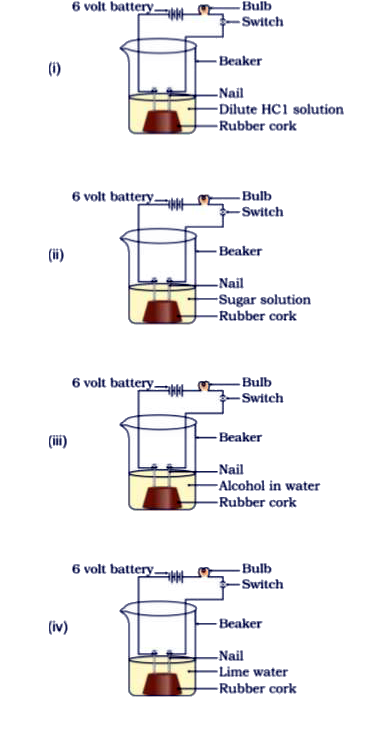Which of the following setups can make a small conductor coil that is placed horizontally float on top of an object ?
The object is a magnet that provides a magnetic field pointing straight downward, whereas the coil carries an electric current flowing clockwise as viewed from top down
The object is a magnet that provides a magnetic field pointing straight downward, while the coil carries an electric current flowing counterclockwise as viewed from top down
The object carries positive electric charge while the coil carries negative charge
The object as well as coil carries negative electric charge
The correct Answer is:D
To determine which setup can make a small conductor coil float horizontally on top of an object, we need to analyze each of the given setups based on the principles of magnetism and electric charge interactions.
1. Understanding the Problem: We need to find a setup where a small conductor coil can float horizontally above an object. This implies there must be a force acting on the coil that counteracts gravity.
2. Analyzing the First Setup:
- The object is a magnet providing a magnetic field pointing straight downward.
- The coil carries an electric current flowing clockwise as viewed from the top.
- Conclusion: A current-carrying coil in a magnetic field experiences a magnetic force. However, since the magnetic field is downward and the current is clockwise, the force on the coil will not be upward. Therefore, this setup will not make the coil float.
3. Analyzing the Second Setup:
- The object is again a magnet providing a magnetic field pointing straight downward.
- The coil carries an electric current flowing counterclockwise.
- Conclusion: Similar to the first setup, the magnetic force acting on the coil will not be upward due to the direction of the current and magnetic field. Thus, this setup will also not make the coil float.
4. Analyzing the Third Setup:
- The object carries a positive electric charge.
- The coil carries a negative electric charge.
- Conclusion: Opposite charges attract each other. Therefore, the negative charge in the coil will be attracted to the positive charge of the object. This attraction will not allow the coil to float; instead, it will move towards the object.
5. Analyzing the Fourth Setup:
- The object and the coil both carry negative electric charges.
- Conclusion: Like charges repel each other. Therefore, the negative charge of the coil will repel the negative charge of the object, which can create a situation where the coil can float above the object due to the repulsive force.
6. Final Answer: Based on the analysis, the correct setup that can make the small conductor coil float horizontally on top of an object is the fourth setup, where both the object and the coil carry negative electric charges.
Summary:
The correct answer is Option 4: The object as well as the coil carries the negative electric charge.
- The object is a magnet providing a magnetic field pointing straight downward.
- The coil carries an electric current flowing clockwise as viewed from the top.
- Conclusion: A current-carrying coil in a magnetic field experiences a magnetic force. However, since the magnetic field is downward and the current is clockwise, the force on the coil will not be upward. Therefore, this setup will not make the coil float.
- The object is again a magnet providing a magnetic field pointing straight downward.
- The coil carries an electric current flowing counterclockwise.
- Conclusion: Similar to the first setup, the magnetic force acting on the coil will not be upward due to the direction of the current and magnetic field. Thus, this setup will also not make the coil float.
- The object carries a positive electric charge.
- The coil carries a negative electric charge.
- Conclusion: Opposite charges attract each other. Therefore, the negative charge in the coil will be attracted to the positive charge of the object. This attraction will not allow the coil to float; instead, it will move towards the object.
- The object and the coil both carry negative electric charges.
- Conclusion: Like charges repel each other. Therefore, the negative charge of the coil will repel the negative charge of the object, which can create a situation where the coil can float above the object due to the repulsive force.
The correct answer is Option 4: The object as well as the coil carries the negative electric charge.
Topper's Solved these Questions
- MAGNETIC FORCEBOOK - RESNICK AND HALLIDAYCHAPTER - MAGNETIC FORCEEXERCISE - Practice Questions (More than one correct choice Type)
11 Videos
- MAGNETIC FORCEBOOK - RESNICK AND HALLIDAYCHAPTER - MAGNETIC FORCEEXERCISE - Practice Questions (Linked Comprehension)
2 Videos
- MAGNETIC FORCEBOOK - RESNICK AND HALLIDAYCHAPTER - MAGNETIC FORCEEXERCISE - Problems
49 Videos
- MAGNETIC FIELDS DUE TO CURRENTSBOOK - RESNICK AND HALLIDAYCHAPTER - MAGNETIC FIELDS DUE TO CURRENTSEXERCISE - Practice Question (Integer Type)
4 Videos
- MOTION ALONG A STRAIGHT LINEBOOK - RESNICK AND HALLIDAYCHAPTER - MOTION ALONG A STRAIGHT LINEEXERCISE - PRACTICE QUESTIONS ( Integer Type )
3 Videos
Similar Questions
Knowledge Check
Which of the following can make its own food ?
AgiraffeBgoatCgrassDgorillaIn which of the following phenomena take place in making of rainbow ?
AReflection, refraction, dispersionBRefreaction, dispersion, total internal reflectionCRefraction, dispersion, total internal reflectionDDispersion, scattering, total internal reflectionWhich one of the following will setup core banking infrasturcture for rural banks ?
ARBIBNABARDCSIDBIDIBA
In which of the following setups would the bulb glow?

View SolutionWhich of the following changes can be reversed?
Straight string to a coiled string
View SolutionWhich of the following metals is used in electroplating to make objects appear shining?
View SolutionWhich one of the following will setup core banking infrasturcture for rural banks ?
View SolutionWhich of the following material is used in making the core of a moving coil galvanometer?
View Solution
